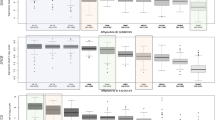Abstract
We have recently identified a protein we called synphilin-1, which interacts in vivo with alpha-synuclein. Mutations in alpha-synuclein cause familial Parkinson's disease (PD). Alpha-synuclein protein is present in the pathologic lesions of familial and sporadic PD, and diffuse Lewy body disease, indicating an important pathogenic role for alpha-synuclein. Here we describe the structure of the human synphilin-1 gene (SNCAIP). The open reading frame of this gene is contained within ten exons. We have designed primers to amplify each SNCAIP exon, so these primers can now be used to screen for mutations or polymorphisms in patients with Parkinson's disease or related diseases. We found a highly polymorphic GT repeat within intron 5 of SNCAIP, suitable for linkage analysis of families with PD. We have mapped SNCAIP locus to Chromosome (Chr) 5q23.1-23.3 near markers WI-4673 and AFMB352XH5. In addition, using immunohistochemistry in human postmortem brain tissue, we found that synphilin-1 protein is present in neuropil, similar to alpha-synuclein protein. Because of its association with alpha-synuclein, synphilin-1 may be a candidate for involvement in Parkinson's disease or other related disorders.
Similar content being viewed by others
Author information
Authors and Affiliations
Additional information
Received: 21 September 1999 / Accepted: 16 March 2000
Rights and permissions
About this article
Cite this article
Engelender, S., Wanner, T., Kleiderlein, J. et al. Organization of the human synphilin-1 gene, a candidate for Parkinson's disease. Mammalian Genome 11, 763–766 (2000). https://doi.org/10.1007/s003350010123
Published:
Issue Date:
DOI: https://doi.org/10.1007/s003350010123




